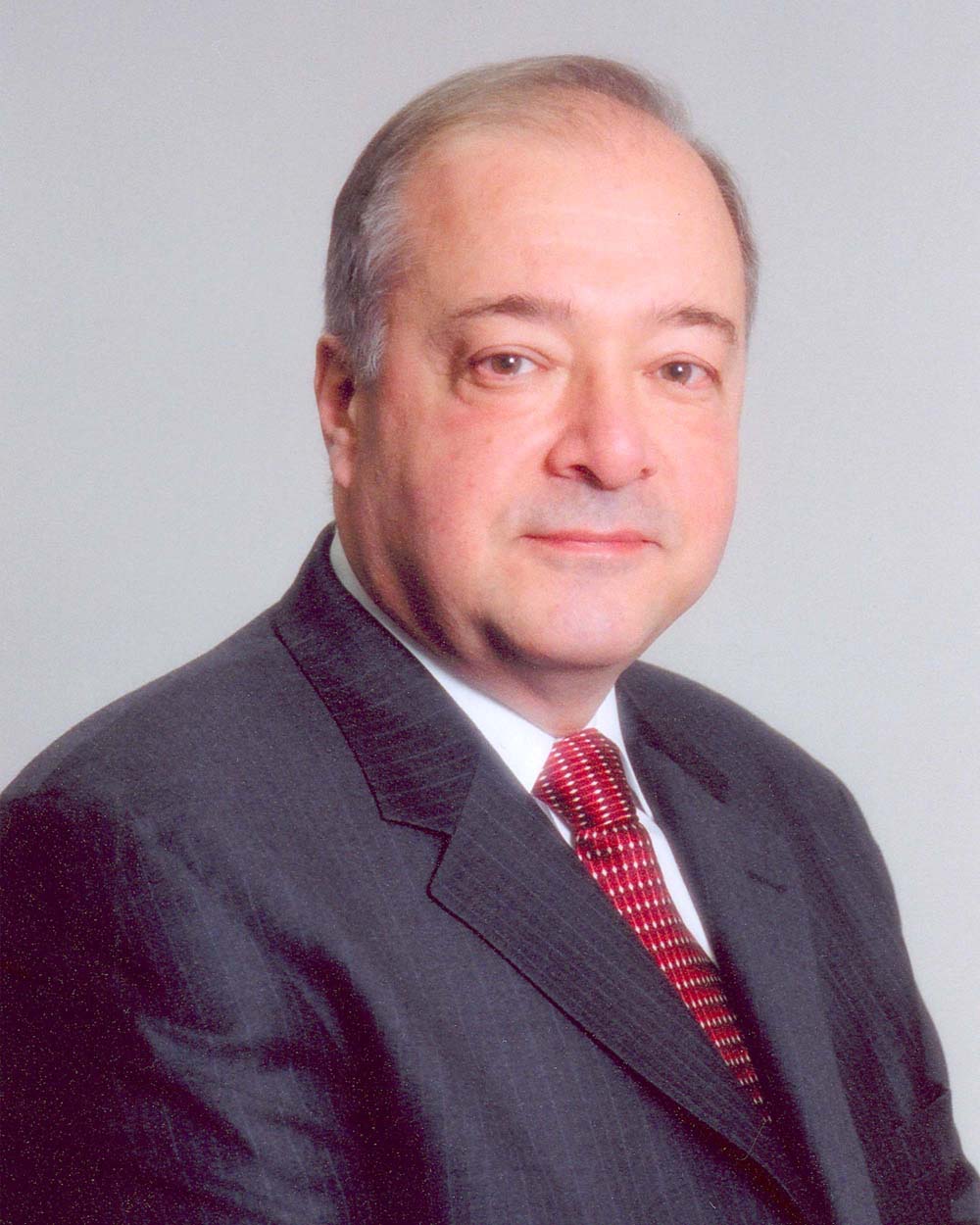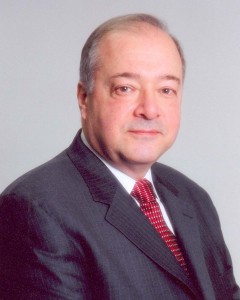
Matthew S. Zuccaro, president of Helicopter Association International, says the FAA’s bill isn’t equitable for GA users and, if passed, will ground GA operations.
By Karen Di Piazza
The biggest aviation debate in recent U.S. history is unfolding on Capitol Hill. The general aviation industry contends that the Bush administration’s funding bill for fiscal year 2008 sets a stage for the Air Transport Association, the lobbying group for the airline industry, to control the air traffic control system through user fees. The GA industry fears that could happen if the House and the Senate vote to enact the Federal Aviation Administration’s funding bill, titled the “Next Generation Air Transportation System Financing Reform Act of 2007,” which was presented to Congress on Feb. 14.
Current FAA authorization funding, including the Airport and Airway Trust Fund, expires Sept. 30. The FAA’s new bill is set to take effect Oct. 1, starting FY 2008. Reauthorization funding cycles each decade.
Numerous congressional hearings have taken place weighing the pros and cons of aviation user fees and higher fuel taxes. The bill is on shaky ground, as the GA industry as well as many members of the House charge that the president’s proposal will reduce funding to operate and modernize the ATC system.
In late March, during a congressional hearing, Rep. Jerry Costello (D-Ill.), chairman of the aviation subcommittee, said if the funding bill were enacted, it would raise $600 million less in FY 2008.
Sen. Sam Brownback (R-Kan.) said using existing law and tax rates would raise more revenue than moving to a user-fee system. He pointed out that the administration’s budget shows that from 2008 to 2012, a user-fee cost-based system “would bring in about $1 billion less in revenue versus the current system” used to fund the FAA. He said the bill would raise less revenue over the next five years, and that he couldn’t see the sense in authorization for a new proposal that would cut funding to modernize our nation’s ATC system.
After reading through the bill, Rep. Vernon Ehlers (R-Mich.) concluded it was “dead on arrival.”
“There’s no way to conclude that this user-fee proposal will work or that it’s equitable,” said Rep. Robin Hayes (R-N.C.), a commercial rated pilot.
Also an active pilot, Rep. Leonard Boswell (D-Iowa) says he opposes the president’s funding scheme because “it’s an unfair and unwise approach.”
Alaska is one state that’s absolutely against the FAA’s funding bill. With backing from the Aircraft Owners and Pilots Association, on April 24, the Alaska State House unanimously passed a resolution opposing the enactment of the provisions in the FAA’s “NextGen” bill.
James Oberstar (D-Minn), the House Transportation and Infrastructure Committee chairman, says he believes the FAA’s proposal “deserves a decent burial.”
Included in the new bill’s proposal is a 350-percent fuel hike for general aviation, a myriad of user-fee taxes placed onto GA users and less congressional oversight of how the FAA institutes the cost for user fees.
Lanny Greenberg, a former FAA employee and the current manager of a federal contract ATC tower in Jackson, Miss., noted that few details have been released about the specific fees.
“Under this proposal, if service fees are imposed for weather briefings or ATC advisories, fewer pilots will request the important information,” he said.
Because this bill has drawn so much attention in the media, and several non-aviation lobbying groups have begun to protest the FAA’s reauthorization package as well, the House and Senate may be forced to delay its enactment. Currently, the House and Senate are trying to work together to produce a revised funding proposal.
Matthew S. Zuccaro, president of Helicopter Association International, a nonprofit organization that represents the civil helicopter industry in more than 68 countries, says the FAA’s bill isn’t equitable for GA users and, if passed, will ground GA operations.
“This issue is of extreme importance, because the FAA proposal is largely corporate welfare for big airlines,” he said. “The FAA plan would transfer billions of dollars of the airlines’ tax burden onto businesses and communities that rely on GA aircraft and helicopters. GA’s planes and helicopters provide essential services for Americans and businesses across the country.”
He said that, unfortunately, the leadership in the Senate Commerce Committee supports user fees for the GA community.
“Some progress has been made in opposing the Bush administration’s FAA bill, particularly within the aviation subcommittee, under the House Transportation and Infrastructure Committee,” Zuccaro said. “But we still have a tough fight ahead of us.”
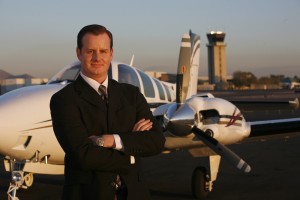
Chad J. Verdaglio, president of Scottsdale, Ariz.-based Sawyer Aviation, LLC, says if this bill passes, they’ll have to change their slogan from “Our plane is ready for takeoff” to “Sorry, our aircraft are grounded—we just got hit with user fees!”
Since most of the FAA’s funding comes from the trust fund, another contentious aspect surrounding FAA funding appropriations centers on whether more general funds collected from the U.S. Department of the Treasury should be allocated to the trust fund. In past years, Congress has been reluctant to appropriate more funds from the general fund, even though GA businesses, airlines, airports, etc., pay taxes into the general fund. The GA industry has long advocated that more money from the general fund should be used to make up for shortfalls in the trust fund.
But the Treasury is responsible for paying all U.S. debt. GA trade groups assert that if the nation’s federal funds weren’t tied up supporting the war in Iraq, for instance, there’d be more money available to support the trust fund.
Meanwhile, FAA Administrator Marion Blakey stands firm on the belief that user fees and higher taxes are essential to fund the agency’s next-generation air transportation system.
“This is the only way to move from ground-based radar to a satellite system,” she said during testimony before the House Aviation Subcommittee. She said the current funding mechanism wouldn’t support the Airport Improvement Program, FAA R&D projects and the Essential Air Service program.
But the subcommittee chairman refuted Blakey’s assertions.
“I question the wisdom of moving to a new funding system that will generate less revenue than the current tax structure provides,” Costello said. “We need to make critical investments to ensure that our nation’s ATC infrastructure is robust for the future.”
After several more lawmakers focused on the fact that the FAA’s funding bill raises less revenue, Blakey reluctantly admitted that the “current system of taxes would raise enough money to fund the ATC system’s modernization.”
Kenneth Mead, the former inspector general of the Transportation Department, calculated that if the budget is left as it is, the FAA would have $20 billion five years from now. Out of that figure, $4.5 billion would be undedicated funds left in the trust fund.
“This is more than adequate to fund the FAA and modernize our airspace system,” says Mead, who serves as counsel for transportation and government affairs for Baker Botts LLP.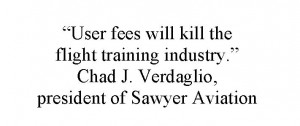
Under the new bill, various tiers of user fees will replace the 7.5-percent airline ticket tax, paid by passengers. According to congressional reports, the airlines stand to gain a considerable tax break under the new FAA bill; however, they’re not required to pass on savings to passengers. In effect, airlines could make more money and keep fares at higher prices; passengers will end up paying for user fees as well.
The new proposal to fund the FAA over the next decade calls for user fees as well as a fuel hike of 70 cents per gallon. Additionally, the bill would impose significantly higher fees for domestic and foreign flights, and for maintenance technical schools, pilot certifications, aircraft registration and certification, pilot license applications, medical exams and more. The bill includes more than 25 fees, some raising existing fees and some completely new.
Included in the 70-cent hike, all GA domestic commercial operations will be charged with a new fuel tax of 13.6 cents per gallon. This will be a separate account to fund the FAA’s R&D, AIP and the EAS programs. The airlines will also pay that tax. The GA industry contends that the FAA’s fuel charge hikes, new tax hikes and new user fees are a complicated, accounting nightmare that will cost more to administrate.
The GA industry says the current pay-at-the-pump excise tax structure is significantly more reasonable and a straightforward approach. Under the current “Taxpayer Relief Act of 1997,” presently all GA turbine and turboprop aircraft pay an excise tax of $0.218 per gallon, piston planes $0.193 and commercial airlines $0.043.
The GA industry believes the propaganda coming from the airlines and the FAA makes it appear as though the airlines are subsidizing commercial GA operations. The industry also believes most people may not be aware of the fact that GA commercial FAR Part 135 air charter carriers and FAR Part 91, subpart K fractional-share operations currently pay several excise taxes.
Arizona is one of the world’s most popular locations for flight training. Chad J. Verdaglio, president of Scottsdale, Ariz.-based Sawyer Aviation, LLC, says that user fees will kill the flight training industry.
“We have charter customers, aircraft owners and flight training clients that would be negatively impacted and deterred by the direct costs and indirect administrative expenses associated with user fees,” he said. “I don’t think the American public is aware of the economic ruin awaiting them if this bill passes. Personally, we’re alerting each of our customers about this bill and encouraging them to oppose it by contacting their representatives in Congress.”
He explained how much a GA commercial operator pays into the system.
“On aircraft weighing more than 6,000 pounds, which most do in our sector of the GA industry, we pay taxes, multiplied by the hourly rate of the flight,” Verdaglio offered. “For instance, we pay a 7.5-percent domestic passenger ticket tax, based on fiscal years Oct. 1, 1999 through Sept. 30 of this year, which is why the FAA authorization funding user-fee debate is so important. Based on a calendar year versus a fiscal year, there’s a domestic flight segment tax, which is $3.40 per passenger for each flight from point A to B—meaning a per leg tax each time the plane takes off and lands. Also based on a CY, we pay $15.10 per passenger for the international arrival and departure tax, which is applicable for departures for foreign destinations and U.S. territories that aren’t subject to the passenger tax.”
He said GA commercial operators pay other taxes, too, but this is the sort of information that the airlines don’t want the public to know about.
“Now the FAA wants all of us to pay user fees, no matter what size aircraft is used,” he said. “How the FAA concluded that a jumbo airliner carrying 350 passengers and, say, an eight-place GA plane should pay the same user fees is beyond my comprehension. Then there’s the Airbus carrying 555 passengers versus a small GA aircraft; this user-fee plan makes no sense. If this bill passes, we’ll have to change our slogan from ‘Our plane is ready for takeoff’ to ‘Sorry, our aircraft are grounded—we just got hit with user fees!'”
The bill also calls for GA to pay user fees to fly within Class B airspace, which typically is near 30 of the busiest airline hub airports. Many say that because of the bill’s actual language, the fee may also incorporate Class C airspace, which means GA will be forced to pay user fees to fly in airspace near hundreds of commercial hub airports.
Congressional Research Service
The Congressional Research Service prepares unbiased reports of bills meant for members of Congress. It stated in its March 14 report that the FAA’s funding proposal will cut funding to the AIP, making it impossible for small GA airports to receive grants to improve facilities. This AIP cut could mean the loss of essential and sometimes lifesaving services to communities that are underserved by the airlines. Conversely, the FAA’s proposal recommends increases in facility charges at airline hub airports, charged to passengers.
The CRS report noted the FAA’s proposal also includes the making of the Air Transportation System Advisory Board, which outlines it will be dominated by commercial airlines’ interest. Although the ATSAB can make “suggestions” to the FAA administrator, the sole decision to raise user fees or make other funding decisions is left to the FAA administrator—without judicial overview from Congress.
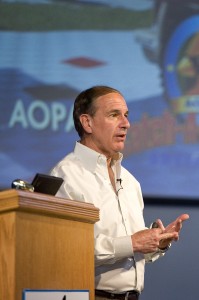
Phil Boyer, president of the Aircraft Owners and Pilots Association, says the FAA has plenty of money to spend on modernization. “The whole idea of user fees is about control,” he said.
The FAA’s proposal, according to the CRS report, seeks to control congestion at certain commercial airports through market-based mechanisms, such as slot auctions and peak-period pricing. Passengers will pay these costs in higher ticket prices.
Alliance for Aviation Across America
On April 10, the Alliance for Aviation Across America launched its campaign to fight the FAA’s funding bill, in an effort to thwart user fees, fuel hikes and numerous other fees. The user-fee debate has moved outside the GA industry and has hit mainstream America. Now, powerful non-aviation groups have also joined the fight against the FAA’s plan. This is getting Congress’ attention, because these groups carry clout when it comes to political campaign backing.
Some of the groups that have joined the AAAA include the National Farmers Union, the League of Rural Voters, the American Corn Growers Association, the Independent Cattlemen of Texas and the Mississippi Livestock Markets Association. Charitable groups, state and local officials, private parties and hundreds of small and medium-sized businesses have joined the alliance.
Those representing GA interests include the National Business Aviation Association, the National Air Transportation Association, the General Aviation Manufacturers Association, the National Association of State Aviation Officials, the National Agricultural Aviation Association, the Experimental Aircraft Association, AOPA, HAI, Angel Flight and Air Care Alliance.
“The coalition was formed to continue the growth and expansion of aviation across America—for all citizens,” said Selena Shilad, AAAA spokesperson. “All the GA trade associations that have backed us have lobbying power on the Hill. And now, with non-aviation groups joining, too, it sends a strong message to the Bush administration that its funding plan isn’t supported.”
The AAAA doesn’t charge a fee for membership and welcomes new members.
“Within 11 days of our launch we had more than 2,400 members; I think that says a lot,” she said. “Our alliance believes we must harness the power of satellite technologies to guide our planes safely and efficiently, but the FAA’s plan isn’t the right way of going about it.”
Shilad says the best interests of the American public—not the airlines’ bottom line—needs to drive the ATC system.
“We must retain congressional oversight and not allow the big airlines to police themselves; that’s absolutely essential,” she said. “The FAA’s project is of great magnitude and requires strict accountability and transparency.”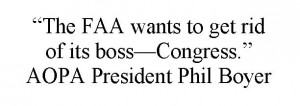
Phil Boyer, AOPA president, said that his group and others such as the NBAA have already made the rounds on Capitol Hill.
“We’ll continue that, but the AAAA goes beyond those of us just in the aviation community,” he said. “Smaller communities depend heavily on air service and will be harmed by the FAA’s legislation, if it goes through.”
The House Transportation and Infrastructure Committee is planning to introduce its own bill in May, overhauling the FAA’s bill. Both Democratic and Republican members of the House are looking at possibly raising fuel taxes for all aviation segments. The Senate Commerce Committee is also expected to introduce an FAA reauthorization bill.
Ed Bolen, NBAA president and CEO, said that if general aviation were grounded tomorrow, the system would cost the same.
“The number of people who fly on commercial airlines far exceeds the number who utilize GA airports,” he said. “The funding proposal is a real sweetheart deal between the FAA and the airlines. From the start of the ATA’s lobbying efforts, it wanted user fees; it wanted to remove itself and the FAA from congressional oversight and it wanted to shift its system costs onto GA. ATA got everything it asked for.”
HAI’s Zuccaro said those who haven’t contacted Congress must want a 350-percent increase in fuel tax.
“You must email or send a letter to each representative in your area—to both the Senate and the House,” he said. “If you think we’ve won the battle against user fees, you’re dead wrong! The public’s voice needs to be heard in Washington if GA is to defeat this dangerous plan.”
After testifying before the House aviation subcommittee on behalf of the helicopter industry, Zuccaro felt the panel didn’t appear inclined to accept the FAA’s claim that the current mix of excise taxes and appropriations won’t meet future ATC system needs.
Debunking FAA myths
In late April, the FAA produced a fact sheet that tried to debunk “the myths” charged by the GA community opposing the FAA’s user-fee bill. The AAAA’s membership viewed the FAA’s new document as its latest attempt to explain the sweet deal it’s giving to the airlines at the expense of the GA community.
On April 25, the AAAA, with help from its GA army, used the FAA’s own statistics against the agency and produced its own fact sheet.
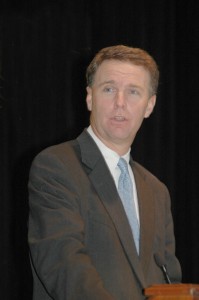
Ed Bolen, National Business Aviation Association president and CEO, says the ATA has always wanted user fees. “It wanted to remove itself and the FAA from congressional oversight and it wanted to shift its system costs onto GA,” he said.
“The FAA claims that user-fee taxes are an effective way to collect revenue and run an ATC system,” Shilad said.
She used Australia as an example of the harm user fees have caused, saying GA has decreased 28 percent in that country since the implementation of user fees. She quoted Dick Smith, former chairman of Australia’s Civil Aviation Safety Authority and a former user-fee supporter, regarding his prediction: “User fees and the commercialization of CASA and air services has been a disaster for GA. I believe the same will happen in the U.S.”
Shilad disputes the FAA’s assertion of GA tax contributions.
“The FAA claims that GA drives 16 percent of ATC service costs, yet contributes only three percent of the taxes,” she pointed out. “The FAA’s own documents show that GA currently contributes 8.6 percent of the taxes that flow into the trust fund.”
The alliance says that until now, the FAA has been using the same economist-accepted cost allocation methodology since 1973. According to AAAA, in the last “properly documented” cost allocation study in 1997, the FAA reported that GA was responsible for 6.7 percent of ATC cost. Another FAA myth, AAAA says, is that in its proposal the FAA has considered the fact that the major airlines drive more of ATC system costs. Alliance members say that the FAA’s cost allocation study treats all turbine aircraft the same, whether it’s an eight-place turboprop or a 400-passenger 747.
The truth, the alliance charges, is that the extensive ATC system cost is driven specifically by the airlines’ hub-and-spoke system. The AAAA said that when airlines insist on shoehorning the majority of air traffic into only 30 hub airports, the FAA must provide increasingly complex and expensive traffic control.
The FAA also claims that the new proposal won’t adversely affect small planes. Shilad refutes that.
“The FAA proposal would increase taxes on GA by a whopping 334 percent, according to the inspector general of the Department of Transportation,” she contended.
The AAAA asserts that the FAA’s claim that small planes will be exempt from user fees isn’t true. The bill clearly designates user fee taxes may be administered on any aircraft flying through Class B or any other type of terminal airspace. The alliance contends that the proposal includes exemption language that will give the FAA the ability to impose user fees on all aircraft, including GA, at its own discretion.
The AAAA is also concerned about the cost required to collect all these new fees.
“According to the FAA, administering the new user-fee system won’t require a large, new bureaucracy,” Shilad said. “But the FAA’s own proposal calls for $1.36 billion to be appropriated for the first 60 days, just for that purpose!”
The FAA continues to assert that in order to modernize the nation’s ATC system, the current funding mechanism must be overhauled. But during recent congressional hearings, the DOT’s inspector general, the Government Accountability Office and the Congressional Budget Office have all stated that modernization can be paid for under the current financing system.
The FAA’s bill would give the airlines a “clear tax break,” says the AAAA. And the GAO told Congress in 2004 that airlines don’t pass tax savings on to passengers, so any tax savings would likely go to airline profitability, not lowering passenger ticket costs.
According to a CRS report, the way the law is currently written, airlines have nearly four months to pay the 7.5 percent passenger ticket tax. Meanwhile, the airlines are allowed to keep the profit from interest collected on the taxes. The report also noted that when interest rates were higher, user fees weren’t a priority, but now that interest rates have dropped, the airlines are looking at user fees as a means to make more money.
AAAA says the FAA and the ATA use mainstream media to scare the public into believing that if user fees aren’t enacted, air safety will suffer. GA groups charge that user fees will actually cause unsafe flying practices.
The National Air Traffic Controllers Association, a branch within the FAA, said it opposes user fees because they will jeopardize safety. The union said FAA’s job foremost should be centered on air safety, not acting as a collection agent.
Will the FAA’s bill cost lives and cut service to small towns?
According to Rol Murrow, Air Care Alliance chairman and president, the airlines’ greed to save $1.7 billion in taxes comes at a high price—leaving Americans without lifesaving GA transportation.
“If the 70-cent fuel hike is imposed onto GA planes and helicopters, public service missions will be hit first—and hit hard,” says Murrow.
Murrow founded the nonprofit ACA to give GA pilots the ability to perform volunteer missions. ACA has under its wing more than 50 aviation groups engaged in public benefit work, both nationally and internationally.

Rol Murrow, Air Care Alliance chairman and president, says the airlines’ greed to save $1.7 billion in taxes comes at a high price—“leaving Americans without lifesaving GA transportation.”
“This bill, if passed, will leave smaller communities without critical medical care and emergency evacuation services,” he said. “Small towns across America depend on GA, as commercial service is almost nonexistent.”
Murrow also serves as president of the Emergency Volunteer Air Corps, a national group that provides voluntary transport services during or after disasters or major public emergencies.
“We estimate that more than 40,000 pilots donate their time and expertise in providing charitable and public benefit patient and medical transport,” he said. “These pilots perform search and rescue, disaster airlift, educational and youth introductory flights and environmental support services.”
Murrow said that more than 125,000 flights were conducted in 2006 for these purposes.
“Since 1985, we estimate nearly one and a half million or more such missions were flown,” he said. “People know how critical these services are. If user fees and higher gasoline taxes are imposed, these pilots won’t be able to afford to offer those free services. That’s going to hurt a lot of American families—and many may suffer the loss of life.”
Karen Halzerson, assistant director of LifeLine Pilots, the main contact for Air Care’s volunteer GA groups, says if the FAA’s funding proposal passes, it will hurt everyone.
“Since 1981, in the Midwest area alone, LifeLine Pilots have provided more than 5,000 lifesaving trips; if this bill goes through, it’s over; the group will fold,” she said sorrowfully. “With volunteer GA pilots, we’ve been able to help transport more than 10,000 people. Sometimes the trip is someone’s last hope to get surgery or medical help they’d never get locally. Without help from our 500 volunteer pilots, this would never happen. Because of pilots who want to ‘give back,’ people’s lives can be saved.”
The National Association of Counties, a nonprofit organization established in 1935 to represent county governments, said that intense lobbying is needed to ensure that underserved communities continue to receive funding through the EAS, AIP and the Small Communities Air Service Program.
Niel Ritchie, the League of Rural Voters’ executive director, said his organization opposes the Bush administration’s proposal because it believes there are better ways to grow and strengthen rural economies.
“Many of the rural communities have been abandoned by commercial aviation and depend on GA,” he said. “The airline-backed plan is a poison pill for rural towns and communities across America. This huge tax hike would ground many of these small planes and puddle jumpers that are the lifeline to these communities, impacting access to specialized medical care, disaster relief and business resources.”
Mayor Gene Wright of Quinwood, W.Va., a veteran pilot since 1965, says people need to send a clear message to lawmakers that they stand united against a “radical” user-fee proposal.
“Our community is dependent on the coal business, and GA plays a key role in air transportation,” he said. “A proposal like this will decimate businesses and communities around our country. We simply can’t afford to lose GA; our whole state depends on it—the nation depends on it. This special interest legislation would benefit no one but the big commercial airlines.”
Is the FAA’s bill too good a deal for the airlines?
The GA industry charges that because the proposed bill eliminates the EAS program and slashes the AIP, isolated communities will suffer and small airports won’t qualify for federal grant funding, while big airline-hub centers can offer full-service spa treatments, gyms and fine dining.
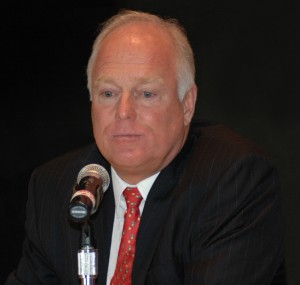
James K. Coyne, National Air Transportation Association president, said the FAA’s proposed Air Transportation System Advisory Board lacks representation from GA businesses. “The ATSAB would be an airline-dominated board,” he said.
In an article dated April 17, The Hill, a nonpartisan weekly newspaper covering Congress and its members, reported that the FAA is making a false claim when it states that U.S. airlines account for 73 percent of the ATC system’s costs, but contribute 95 percent of the systems trust fund revenue. The publication reported it had obtained an internal Air Transport Association document that indicates U.S. airlines paid only about 74 percent of total contributions to the trust fund; the 95-percent figure comes only after adding “foreign airlines and shippers such as FedEx” into the formula. The magazine says a commercial aviation source refuted that argument, saying that commercial airlines contribute a total of about 94 percent.
Henry Ogrodzinski, president and chief executive of the National Association of State Aviation Officials, called the FAA proposal “a terrible bill.”
“It makes no sense; the FAA funding bill isn’t in the public’s best interest,” he said. “The Bush administration is going in the right direction towards passenger facility charges for our nation’s larger airports, but it hasn’t gone far enough.”
NASAO believes the PFC should be at least $7.50 per person.
James K. Coyne, NATA president, said the FAA’s proposed Air Transportation System Advisory Board lacks representation from GA businesses.
“The ATSAB would be an airline-dominated board,” he said. “The 14-person board won’t have a single representative from on-demand charter carriers or fractional ownership providers. These two GA groups provide significant contributions to the trust fund.”
Eric Byer, NATA’s vice president of government affairs, says no one knows who will be “appointed” to the board.
“The FAA intends to include at least three airline operatives representing various commercial sectors, but it’s completely ignoring the airlines’ competitors—charters and fractionals,” he said. “This shows the FAA’s bias towards the airlines. There’s just no excuse for ignoring these segments of aviation.”
The FAA administrator will also sit on the proposed board.

Eric Byer, NATA’s VP of government affairs, says the FAA will include at least three airline operatives representing various commercial sectors on its new board. “It’s completely ignoring the airlines’ competitors—charters and fractionals,” he said.
Bolen says the FAA’s proposal and its litany of new user fees will cut jobs throughout the GA industry.
“The costs for GA will increase exponentially,” he said. “On the other hand, according to the GAO, when passenger ticket taxes lapse, airlines don’t pass along their tax windfall to passengers. When passenger ticket taxes have lapsed in the past, some airlines actually raised passenger fares. That seems to be the airlines’ plan under the new proposal. One senior airline executive was recently quoted in a major newspaper saying, ‘If Congress adopts their plan, the airlines could keep fares the same and make more money.'”
Bolen says the FAA’s plan is not an aviation modernization bill.
“The plan doesn’t outline the technologies, timelines or costs of the next phase of modernization envisioned for the national air transportation system,” he said. “The FAA plan reduces the general fund contribution by hundreds of millions, and diverts money that could and should be spent on runways, towers and modernization technologies and wastes it on a new bureaucracy. After all that, it allows the FAA to go into debt. The GA community has led the way on system transformation; the FAA talks the talk, but doesn’t walk the walk on modernization.
“The big airlines’ FAA bill would replace the ultra-efficient fuel and ticket tax system with a huge new, multibillion dollar bureaucracy of billing agents, collection agents, auditors, dispute arbitrators and others. The International Air Transport Association has reported that it costs IATA members anywhere from $85 to $125 to process a single invoice.”
Bolen said the FAA’s scheme strips Congress of most of its role in aviation system funding decisions.
“The airlines’ lobbyists have said, ‘We need to get Congress out of this process,’ and the FAA’s bill reflects that desire,” he said. “But we do need to modernize our ATC.”
He said that, as other sources have noted, the current funding structure offers several ways to do that.
“Specifically we need to fully fund the FAA and move forward with a comprehensive modernization plan, which includes timelines and cost estimates,” he said. “We need to enhance accountability by increasing transparency and retaining strong congressional oversight. We need to maximize industry tax dollars by retaining an ultra-efficient tax system that doesn’t require a huge new bureaucracy or dilute the FAA’s focus on safety. And we must retain a general fund contribution that reflects the public benefit inherent in a strong national air transportation system.”
Boyer says the FAA’s bill isn’t about money.
“The FAA has plenty of money to spend on modernization,” he said. “The whole idea of user fees is about control. The FAA wants to get rid of its boss—Congress. And the airlines would like to wrest control of the ATC system through the new FAA management board. Then they’ll have more say in how the system is run and how the money is spent.”
Boyer believes that the airlines want even more power than the FAA has offered.
“The airlines don’t think the final bill that the FAA has put forth gives them enough seats on the board,” he said. “They won’t have enough control, and they’re very open about saying it. That control change won’t happen if user fees don’t happen.”
The current bill, says Boyer, proposes an estimated $5 user fee for general aviation flying in Class B airspace. He said it would cost the federal government much more than $5 to collect that fee.
“The larger issue is what happens down the road,” he said. “First, the airlines will pay user fees for en route and terminal ATC services. Then they’ll say, ‘Hey, this isn’t fair; business jets use the same services.’ Then the fees will trickle down to them. Then the airlines will say, ‘Piston aircraft flying IFR are using these services, too.’ The fees will hit them.”
He said that, finally, even GA aircraft flying VFR will get fees, because they’re using control towers and filing flight plans.
“It’s happened in New Zealand, it’s happened in Australia and it’s happened in Europe, which has destroyed general aviation,” Boyer said. “It’s more than ironic that a chronically bankrupt industry—which has mismanaged its affairs to the point that it can’t even pay full employee pensions—is now telling Congress what it ‘must’ do to run the FAA as a business.”
AOPA’s anti-user-fee theme focus at Sun ‘n Fun
During last month’s Sun ‘n Fun Fly-In, held in Lakeland, Fla., Boyer spent most of his time addressing the media and collecting signatures on 15-foot wide, seven-foot tall petitions, to oppose the FAA’s bill. By April 23, more than 22,000 people had signed.
GA pilots are angry over the FAA’s proposal, including Phil Murray of St. Cloud, Fla.
“The commercial airlines are trying to get us to pay for their mistakes,” Murray quipped. “They’re trying to get another bailout, because they can’t manage their own businesses.”
After signing the petition, D.J. Merrill, a GA pilot from Durham, N.C., called the FAA proposal “stupid and shortsighted.” He added that if Congress passes the bill in its current form, “It’s going to kill aviation as we know it.”
Boyer, a former ABC television executive, said the aviation community’s vast silent majority does not and will not support the FAA’s scheme.
“Nine out of 10 AOPA members have said they will reduce or curtail their flying if the fuel hike tax is increased,” he said. “Congress is already sitting up and taking notice. The FAA and its administrator need to do so as well.”
Before it’s too late
NBAA announced on April 23 that it had created a new Online Advocacy Center to “fight the big airlines’ user-fee proposal.”
“When people in the general aviation community hear about the user fees and a tripling of taxes in the airlines’ FAA scheme, their first question is, ‘What can be done to oppose it?'” Bolen said. “People must contact members of Congress, by email, fax or letter. We have to do a lot of work to win this battle.”
The OAC website provides information about the FAA’s funding proposal and shows how to send email messages to members of Congress and how to write letters to editors of publications. It also provides office contact information for each member of the House.
FAA’s complicated funding bill addresses layers of fees for services, new depository accounts and appropriation methods.
AOPA’s “Funding Debate” website page offers members an opportunity to calculate their future 70-cent hike in fuel bills. When pilots start doing the math, user fees will sink in. AOPA hopes that will provide the spark for more people to actively oppose the FAA’s bill. Its website also provides a copy of the FAA’s 83-page funding proposal and provides information on how to fax or write letters to members of Congress.
The AAAA also provides a ready-made form letter to email letters to members of Congress.
Boyer said while the number of legislators opposing the FAA’s bill continues to grow, in the ways of Washington, nothing’s ever final until the final vote. Bolen agreed, adding that this is no time to sit back.
“If all of us protest this illogical funding scheme, we can win this,” he said. “But we need your help to oppose the FAA’s bill—so all Americans can continue to receive the benefits that GA offers.”
Lott-Rockefeller bill
On May 2, Senators Trent Lott (R-Miss) and Jay Rockefeller (D-W.Va.) drafted a bill that differs from the FAA’s funding proposal. The GA community also opposes this bill, tentatively set for a House mark-up session May 8. The bill calls for removal of the commercial airlines’ excise fuel tax, which would save the airlines nearly $500 million annually.
The bill includes new user fees for GA turbine and turboprop planes, along with increased fuel excise taxes. The proposal is said to exclude piston-powered aircraft from user fees or new taxes and calls for continued commercial airline ticket taxes, paid by passengers. At press time, exact language in the bill wasn’t available. It’s unclear if commercial GA operations would continue to pay existing tiers of federal excise taxes in addition to new user fees and fuel tax hikes.
Several members of Congress have publicly denounced this bill as it calls for the removal of the House’s oversight on FAA spending. The Lott-Rockefeller bill proposes that the Senate oversee FAA funding for the ATC system.
For more information on how to fight the FAA’s bill online, visit the NBAA’s Online Advocacy Center website at [http://www.nbaa.org], AOPA’s Funding Debate page at [http://www.aopa.org] or AAAA at [http://www.aviationacrossamerica.org].











